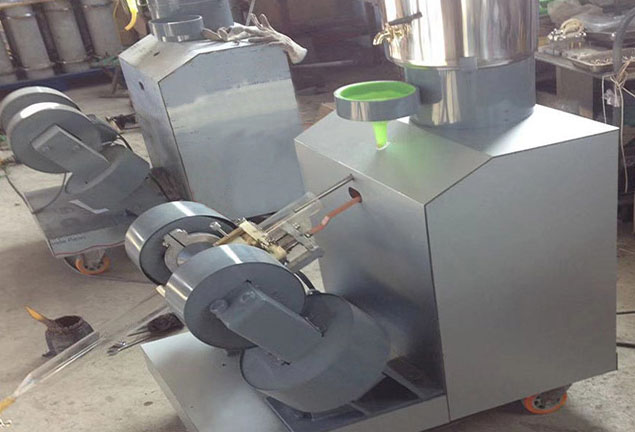Fluorite is widely used in the metallurgy, chemical, and building materials industries like glass, ceramics, and cement. As more and more people join the fluorite beneficiation industry, it is also necessary to have some mining beneficiation knowledge. Nowadays, there are three main beneficiation processes for fluorite ore. They are manual beneficiation, gravity (jig) beneficiation, and flotation. Given the impoverishment of fluorite raw ore and the characteristics of fluorite and gangue intercalation, flotation has become the most commonly used beneficiation method for separating fluorite and gangue minerals. Let’s take a look at the fluorite beneficiation process together.
Fluorite Beneficiation Process
Fluorite ore crushing and screening
This stage mainly involves the initial crushing of fluorite ore, achieving effective dissociation of the material structure of rock ore, and reducing the difficulty of subsequent grinding. Generally, it will use small and efficient jaw crushers, hammer crushers, and double roller crushers to crush the material.
Grinding process for fluorite ore
The main function of the fine grinding stage is to separate the useful components in the fluorite mineral structure from the gangue, providing favorable conditions for subsequent separation and improving the ore dressing grade as much as possible. At this time, gold ball mills were often used as important grinding equipment to prepare for ore dressing.
Fluorite ore classification and cleaning
The separating stage includes classification equipment such as spiral classifiers and flotation machines. The spiral classifier classifies the ground rock ore powder (slurry), and unqualified ore powder with larger particle size returns to the ball mill for grinding. A flotation machine uses the effect of flotation reagents to extract the selected fluorite ore and obtain high-grade fluorite concentrate slurry, which is the product desired by the fluorite flotation process.
Flotation and drying of fluorite ore:
To make fluorite ore concentrate used in industry, its physical state needs to be changed. The gold concentrate in the slurry state needs to be precipitated, concentrated, dried, and dehydrated to obtain the finished fluorite ore concentrate powder. This stage requires equipment such as thickeners and dryers.

Laboratory Fluorite Ore Beneficiation Equipment
1. Jaw crusher
- Introduction: The lab jaw crusher is for crushing big stones into small pieces. Laboratory-sealed jaw crusher applies to medium and fine crushed materials for laboratory and production. It is widely used as environmental protection equipment for coal, electric power, mining, geology, chemical, metallurgy, building materials, and other industries.
- Application: The jaw crusher is commonly used in various construction, aggregate crushing lines, and crushing sections in the lab mineral processing industry.
- Process: Put 100mm fluorite ore into the jaw crusher from the feeding port. After starting, the two teeth press against each other, crushing the material into small particles to 10mm, and then discharge them from the discharge port.
- For a big jaw crusher, it is suitable for crushing granite, limestone, river pebbles, marble, etc. Lab jaw crusher is suitable for crushing small amounts of rock stone ores into small particles.
2. Ball mill
- Purpose: Further crush fluorite ore to 200 mesh for the next flotation experiment.
- Experimental process: In fluorite ore beneficiation, Lab ball mills are used to grind materials, making the finished product reach 0-1mm or finer. Pour 10mm of the broken material into the ball mill and add grinding steel balls. At this point, you can see that the ball mill rotates continuously, and the grinding steel balls inside will grind the material into powder.
- In the mining industry, ball mills are suitable for grinding various mineral ores, such as copper, iron ore, lead zinc ore, etc. In the mining industry, a ball mill is a machine used for grinding raw materials to the required particle size for subsequent processing processes such as flotation and beneficiation.
3. Spiral classifier
- The spiral classifier is one of the mineral processing equipment. The spiral classifier uses the principle of the specific gravity of solid particles. Resulting in different sedimentation rates in liquids to perform mechanical classification. The material powder produced in the mill is graded and filtered, then the coarse material can be rotated into the feed port of the mill using spiral blades, and the filtered fine material is discharged from the overflow pipe.
- Experimental process: The material from the ball mill enters the classifier for classification, and gets the fluorite ore.
- Spiral classifiers are commonly used to process minerals such as cassiterite, chromite, ilmenite, zircon, and monazite, and can also be used to recover heavy minerals from flotation tailings.
4. Flotation machine
- Purpose: Enriching fluorite concentrate and improving grade
- The function of the laboratory flotation machine: it is a common separation equipment that requires the addition of conventional reagents. The chemicals required to handle different materials also vary.
- Experimental process: Pour the slurry into the tank and dilute it with water to the desired concentration; Start the motor and add an appropriate amount of flotation agent according to the experimental requirements; When foam is generated in the tank, turn on the switch of the scraper part to start flotation; After reaching the specified flotation time, turn off the motor and stop the impeller and scraper from running.
- The flotation machine is suitable for improving the grade of minerals like gold sulfide, lead zinc, copper ore, lithium ore, etc.
Above is the mining testing equipment for tungsten gold spodumene ore. JXSC lab mineral processing equipment manufacturer has more than 38 years of experience in mining processing. We provide laboratory equipment suitable for minerals such as gold, tin, tungsten, lead, zinc, tantalum, niobium, iron, manganese, silver, titanium-iron, etc. Machines include laboratory jaw crusher, hammer crusher, roller crusher, grinding equipment, mineral separating equipment, screening, washing equipment, etc. Welcome to consult if you are interested in our lab equipment!





